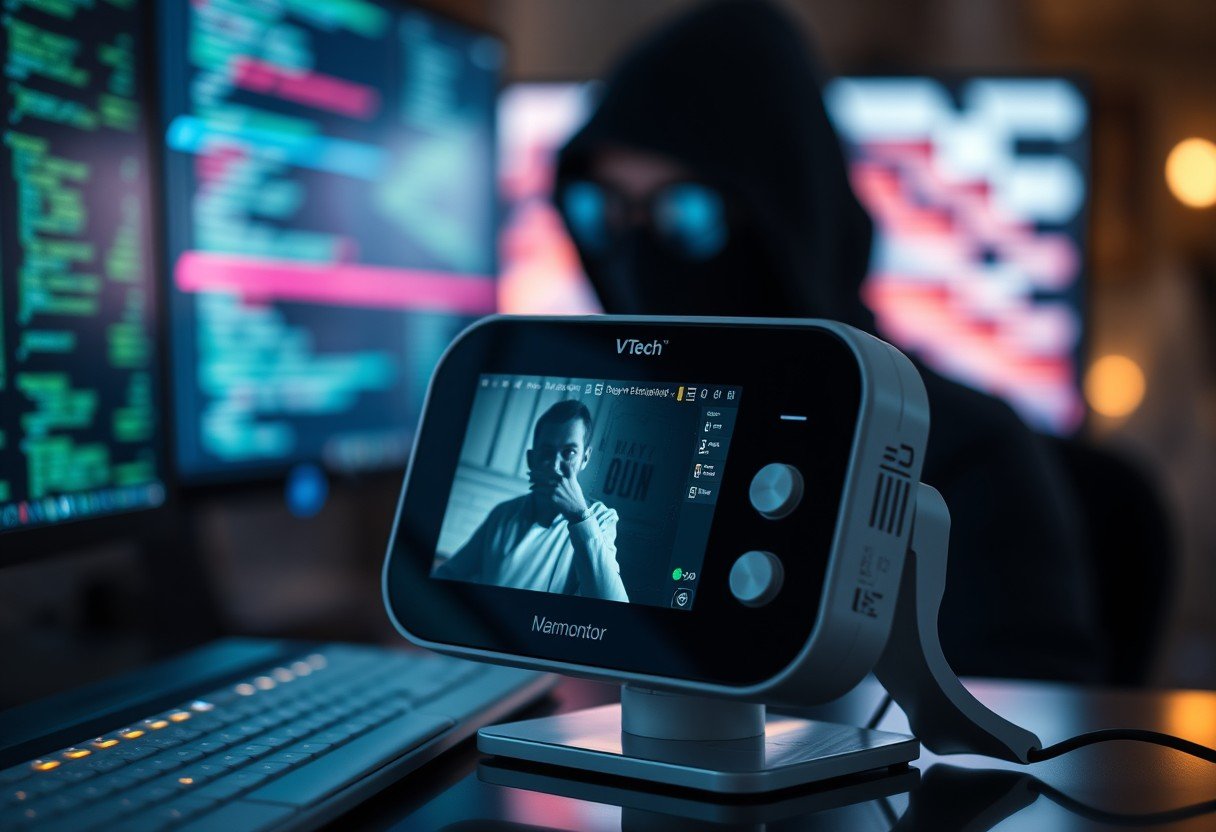VTech baby monitors were a trusted choice for parents, but a major hacking incident in 2015 revealed serious security problems. Hackers exploited simple weaknesses like unsecured Wi-Fi connections, a lack of data encryption, and easily guessable default passwords. This allowed them to access live video and audio feeds, creating a nightmare for families. This article explains how it happened and what you can do to protect your home and your children from similar threats.
Why Were VTech Baby Monitors an Easy Target?
The vulnerabilities in VTech baby monitors were not complex; they were basic security oversights that created a perfect storm for hackers. These issues made it surprisingly easy for unauthorized individuals to gain access to the devices remotely.
A significant issue was the transmission of unencrypted data. When information travels between the camera and your parent unit or phone app without encryption, it’s like sending a postcard through the mail. Anyone who intercepts it can read it. Hackers could easily capture the video and audio streams by “listening in” on the Wi-Fi network.
Furthermore, the company’s password policies were extremely weak. Many devices came with default passwords that users never changed, or people chose simple passwords like “123456” or “password.” This, combined with the lack of mandatory software updates, meant that known security holes were left open for years, giving cybercriminals a clear path into people’s homes.
These technical weaknesses and security oversights were not unique to a single model but were present across a range of VTech products. The failure to prioritize fundamental security measures like strong encryption and forced password changes left thousands of families exposed without their knowledge.
The 2015 VTech Hacking Incident Explained
The reality of these vulnerabilities hit home for families on December 23, 2015. On that day, reports began to surface from distressed parents who heard unfamiliar voices speaking through their baby monitors and saw the camera’s direction changing on its own. It quickly became clear that these were not isolated glitches but a widespread hack.
The impact on users was immediate and profound. The very device that was meant to provide peace of mind had become a source of fear and anxiety. Parents felt a deep sense of betrayal and violation, realizing that strangers could have been watching their children sleep or play. The incident shattered the trust many people had placed in smart home technology.
This event served as a major wake-up call for both consumers and manufacturers. It highlighted the urgent need for better security standards in Internet of Things (IoT) devices, especially those used to monitor the most vulnerable members of our families. For many parents, the experience led them to stop using their monitors altogether.
What Are the Privacy Risks of a Hacked Baby Monitor?
When a baby monitor is hacked, the consequences go far beyond a simple security breach. It represents a severe invasion of a family’s most private moments. The possibility of unseen individuals watching or listening to your children raises serious ethical and safety questions.
The most immediate risk is the loss of privacy. Hackers can access live video and audio feeds, effectively placing a spy inside your home. This footage could be watched in real-time or even recorded and shared online. This exposure violates your family’s right to safety and security in your own home.
Beyond the immediate privacy invasion, there are other potential dangers. Information gathered from the monitor, such as your child’s name, daily routines, or even the layout of your house, could be used for more malicious purposes. This raises the stakes from a simple privacy breach to a potential physical security threat. The incident prompted governments and regulatory agencies to look more closely at data protection laws for connected devices, pushing for stricter rules to hold companies accountable.
How to Secure Your Baby Monitor from Hackers
Protecting your family from these threats requires a proactive approach to security. Fortunately, there are several straightforward steps you can take to make it much harder for anyone to gain unauthorized access to your baby monitor.
The first line of defense is your home Wi-Fi network. If your network is not secure, none of the devices connected to it are truly safe. Always protect your router with a strong, unique password and use the highest level of encryption available, preferably WPA3.
You should also pay close attention to the device’s own settings. Never use the default username and password that come with the monitor. Create a strong password that combines upper and lowercase letters, numbers, and symbols. Here are other essential practices:
- Keep Software Updated: Manufacturers release software updates, or “patches,” to fix security flaws. Enable automatic updates if possible, or manually check for them at least once a month.
- Turn Off Remote Access When Not Needed: If you only use the monitor while you are at home, disable the feature that allows you to view the feed over the internet. This closes a major entry point for hackers.
- Use Two-Factor Authentication (2FA): If your monitor’s app offers 2FA, enable it. This adds an extra layer of security by requiring a second code, usually sent to your phone, to log in.
By implementing these practices, you can dramatically improve the security of your device.
Quick Security Checklist
| Weak Security (Avoid) | Strong Security (Implement) |
| Using the default password “admin” or “123456” | Creating a unique password with 12+ characters |
| Connecting to public or unsecured Wi-Fi | Using a password-protected home network with WPA3 |
| Never updating the device’s software | Enabling automatic updates or checking monthly |
| Leaving remote access on at all times | Disabling remote viewing when not in use |
How the Industry Responded to Security Threats
The VTech hacking incident sent shockwaves through the baby monitor and smart home industry. In response, many manufacturers began to take security much more seriously, realizing that a single breach could destroy customer trust and brand reputation.
Companies started implementing stronger security features that are now becoming standard. This includes end-to-end encryption, which scrambles the data so that only you can see it. Manufacturers also improved their processes for notifying customers about security updates and made it easier for users to apply them.
You will now find that new baby monitors come with advanced safety measures built-in. Features like two-factor authentication, which were once rare, are now common. There is also a greater industry-wide collaboration to establish better security protocols for all IoT devices, ensuring that the products you bring into your home are designed with your family’s safety as a top priority.
Frequently Asked Questions
How were the VTech baby monitors actually hacked?
Hackers exploited several weaknesses, including unsecured Wi-Fi connections, a lack of encryption on video and audio streams, and the use of default or very simple passwords by users. This combination allowed them to intercept the data and gain control of the devices.
What can I do to make my baby monitor safe?
To secure your monitor, always change the default password to a strong, unique one. Ensure your home Wi-Fi network is password-protected with WPA3 encryption, and regularly update your monitor’s software to patch any security holes.
Are new baby monitors more secure now?
Yes, following major incidents like the VTech hack, many manufacturers have significantly improved security. New models often include essential features like end-to-end encryption and two-factor authentication to better protect your family’s privacy.
Can a baby monitor that doesn’t use Wi-Fi be hacked?
Monitors that use radio frequencies (like FHSS) instead of Wi-Fi are generally considered more secure from remote hacking over the internet. However, someone with the right equipment could potentially intercept the signal if they are physically close to your home.
What did VTech do to fix the problem?
VTech responded by improving its encryption methods, updating its software to fix the vulnerabilities, and providing customers with clearer instructions on how to secure their devices and home networks. The company has since committed to more robust security practices.








Leave a Comment